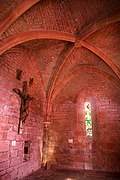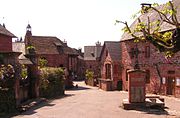Collonges-la-Rouge
Collonges-la-Rouge | |
|---|---|
 Collonges-la-Rouge | |
| Coordinates: 45°03′40″N 1°39′18″E / 45.061°N 1.655°E | |
| Country | France |
| Region | Nouvelle-Aquitaine |
| Department | Corrèze |
| Arrondissement | Brive-la-Gaillarde |
| Canton | Midi Corrézien |
| Government | |
| • Mayor (2020–2026) | Michel Charlot[1] |
Area 1 | 14.31 km2 (5.53 sq mi) |
| Population (2021)[2] | 479 |
| • Density | 33/km2 (87/sq mi) |
| Time zone | UTC+01:00 (CET) |
| • Summer (DST) | UTC+02:00 (CEST) |
| INSEE/Postal code | 19057 /19500 |
| Elevation | 144–493 m (472–1,617 ft) (avg. 230 m or 750 ft) |
| 1 French Land Register data, which excludes lakes, ponds, glaciers > 1 km2 (0.386 sq mi or 247 acres) and river estuaries. | |
Collonges-la-Rouge (French pronunciation: [kɔlɔ̃ʒ la ʁuʒ], literally Collonges the Red; Occitan: Colonjas) is a commune in the Corrèze department in the Nouvelle-Aquitaine region of France.
Location
[edit]The village is located twenty kilometres south-east of Brive-la-Gaillarde, on the edge of the Limousin plateaus to the north and facing the Quercy, four kilometres to the south.[3] It is located on the Causse Corrèze at the northern end of the Causse de Martel.
History
[edit]The monks of Charroux Abbey founded a priory in the 8th century which attracted a population of peasants, craftsmen and tradesmen who lived and prospered around its fortified walls. The welcoming of pilgrims for Compostelle through Rocamadour was a lasting source of profit. In 1308, the viscount of Turenne granted the village a right to high, medium and low jurisdiction, permitting it to govern the birth of lineages of prosecutors, lawyers and notaries. The enclosure soon became too small to contain the entire population, and faubourgs were created. Following the French wars of religion, the reconstruction of the nobility's fortune coincided with the viscount's rise in power.
After selling the viscounty in 1738, and after the French Revolution which caused the destruction of the priory buildings, the village regained a short-lasting prosperity at the beginning of the 19th century. Later on, its population slowly decreased and the village was transformed into a stone quarry.
At the beginning of the 20th century, some villagers created the association Les Amis de Collonges (The Friends of Collonges) and eventually obtained the classification of the entire village as a historical monument in 1942.
Population
[edit]| Year | Pop. | ±% p.a. |
|---|---|---|
| 1968 | 375 | — |
| 1975 | 360 | −0.58% |
| 1982 | 379 | +0.74% |
| 1990 | 381 | +0.07% |
| 1999 | 413 | +0.90% |
| 2009 | 464 | +1.17% |
| 2014 | 490 | +1.10% |
| 2020 | 483 | −0.24% |
| Source: INSEE[4] | ||
Its inhabitants are called Collongeois in French.
Sights
[edit]Collonges-la-Rouge is entirely built with red sandstone. Its existence is proven since the 8th century thanks to the donation of the count of Limoges of the parish to the monastery of Charroux.
The village is a member of the Les Plus Beaux Villages de France (The Most Beautiful Villages of France) association. It was actually the first village to be part of the association since it was created by the mayor of Collonges-La-Rouge, Charles Ceyrac.
It is one of the most visited sites in the Nouvelle-Aquitaine.
Civil architecture
[edit]The Halle Henri IV is a grain and wine market hall dating from the late sixteenth or early seventeenth century. It still houses the communal oven that was still in use in 1968 (it is now only relit on the first Sunday of August, for the annual bread festival).[5] The covered market hall is listed as a historical monument.[6]
Houses
[edit]- Maison de la Sirène, possesses a vaulted porch and dates to the 16th century. It belonged to Henry de Jouvenel, one of writer Colette's husbands. It is listed as a historical monument. A 3 franc postage stamp representing the Maison de la Sirène was issued on July 3, 1982[7]
- A priory, built in the 16th century, has been a historical monument since July 4, 1951 for its facade with balcony and its roof;[8]
- the ancient sisters' house (Ancienne maison des Soeurs), built in the 16th century, has been a historical monument since July 4, 1951;[9]
Rue de la Barrière (Barrière Street)
- 16th-century Maison Bonyt is a historical monument for its facade, roof and spiral staircase;[10]
- Maison Boutang du Peyrat, with parts from the 15th, 16th and 17th centuries, is a historical monument. The protected elements are a window with preserved Louis XIII woodwork, a 17th-century entrance door, a wooden chimney, its facade and roof;[11]
- 16th-century Maison Julliotis a historical monument for its facade, roof and entrance stairs;[12]
- Maison Dey is a historical monument;[13]
- A 16th and 18th-century house on the Place de la Halle is a historical monument for its facade, loggia, and roof;[14]
- Maison Poignet has a 17th-century window listed as a historical monument;[15]
- Maison Salvant et Vallat is also a historical monument.[16]
Official buildings
[edit]- The Ancien tribunal de la Chatellerie (ancient court of the Châtellerie) (16th century) has been a historical monument since December 13, 1978[17]
- The ancient town hall (with parts from the 16th, 17th and 18th centuries) has its facade, roof, and stone chimney listed as national monuments since January 4, 1951[18]
Castles, hotels and noble houses
[edit]- Manoir de Vassinhac (14th and 16th centuries), with elements of fortifications, is a historical monument;[19]
- Château or hôtel du Friac or de Beaurival (hôtel de Beaurival), 15th century, is a historical monument since December 17, 1926;[20]
- Château de Benge, with parts from the 16th and 18th centuries, was listed as a historical monument by the orders of September 23, 1953 and March 18, 1954;[21]
- Castel Maussac, 15th and 16th centuries, has been a historical monument since December 17, 1926;[22]
- Château du Breuil;
- Château du Martret, with parts from the 16th and 19th centuries, is a historical monument;[23]
- Manoir dit de Beauvirie, 16th century, is a historical monument;[24]
- Château de Beauregard, 15th century, has been a historical monument since December 17, 1926.[25]
Military architecture
[edit]The fortified wall dates back to the 14th century.[26] The doors of the ancient priory and of the church are both listed as historical monuments.
Religious architecture
[edit]Église Saint-Pierre de Collonges-la-Rouge
[edit]The Saint-Pierre church, dating from the 11th, 12th and 15th centuries, with its romance curved steeple (one of the oldest of the Nouvelle-Aquitaine region), was fortified during the 16th-century French wars of religion. Its remarkable gates are decorated with a 12th-century tympanum carved in white stone (contrasting with the red stone of the rest of the village), representing the ascension of Christ dominating his mother and the 11 apostles. It was hidden during the wars of religion and only replaced in 1923.
The main altar, painted in blue and gold, is composed of a 19th-century altar, a partly 17th-century tier, an 18th-century tabernacle, and an altarpiece reconstructed in the 19th century with elements two centuries older. It was listed as a national treasure and restored in 1984-1985.
The altar (wooden and painted in gold) of the southern chapel represents the Passion and dates back to the end of the 17th century. It is also listed as a historical monument.
The wooden fence of the chapel, with a central turnstile, dating back around the turn of the 18th century, is decorated with coquilles, volutes and sculpted acanthus leaves. It is listed.
The 16th-century wooden statue of Christ was discovered in 1971. It is a historical monument, with two other statues of the Virgin Mary, from the 17th or 18th century. A wooden Christ on the cross dates back to the 17th century, and is listed. The whole church has been a historical monument since 4 April 1905.[27]
-
Tympanum of the church's gate
-
Saint-Pierre church's steeple
-
Saint-Pierre church's gate
-
The back of the church
La Chapelle des Pénitents Noirs
[edit]The Chapel of the Black Penitents dates from the 14th century and belonged to the priory of Collonges. From the beginning, it was used for the burial of certain local notable families, notably the Maussacs, whose coat of arms can be seen above a walled door and on a keystone of the chapel. From the middle of the seventeenth century until the end of the nineteenth century, it was then called th Chapel of the Black Penitents. After the disappearance of the brotherhood, the chapel fell into disrepair. The Société des Amis de Collonges undertook restoration work from 1927 onwards.[28]
-
La chapelle des Pénitents noirs and la Croix de la Passion.
-
Chapelle des Pénitents.
Gallery
[edit]-
A street of Collonges-la-Rouge
-
A street of Collonges-la-Rouge
-
Towers
-
Place de Collonges-la-Rouge
-
Church as seen under a porch
-
Castel de Vassinhac
-
Castel de Vassinhac
-
Castel de Vassinhac and church
-
Maison de la Sirène
See also
[edit]References
[edit]- ^ "Répertoire national des élus: les maires" (in French). data.gouv.fr, Plateforme ouverte des données publiques françaises. 13 September 2022.
- ^ "Populations légales 2021" (in French). The National Institute of Statistics and Economic Studies. 28 December 2023.
- ^ "Village de Collonges-la-Rouge et ses abords" (PDF). www.nouvelle-aquitaine.developpement-durable.gouv.fr. Retrieved 24 March 2024.
- ^ Population en historique depuis 1968, INSEE
- ^ France, Centre (3 August 2018). "Fête du Pain de La Vie Collongeoise". www.lamontagne.fr. Retrieved 24 March 2024.
- ^ "Halle". www.pop.culture.gouv.fr. Retrieved 24 March 2024.
- ^ "Maison du 16e siècle dite « maison de la Sirène »". www.pop.culture.gouv.fr. Retrieved 24 March 2024.
- ^ "Ancien prieuré". www.pop.culture.gouv.fr. Retrieved 24 March 2024.
- ^ "Ancienne maison des Soeurs". www.pop.culture.gouv.fr. Retrieved 24 March 2024.
- ^ "Maison Bonyt". www.pop.culture.gouv.fr. Retrieved 24 March 2024.
- ^ "Maison Boutang du Peyrat". www.pop.culture.gouv.fr. Retrieved 24 March 2024.
- ^ "Maison Julliot". www.pop.culture.gouv.fr. Retrieved 24 March 2024.
- ^ "Maison Dey". www.pop.culture.gouv.fr. Retrieved 24 March 2024.
- ^ "Maison". www.pop.culture.gouv.fr. Retrieved 24 March 2024.
- ^ "Maison Poignet". www.pop.culture.gouv.fr. Retrieved 24 March 2024.
- ^ "Maison Salvant et Vallat". www.pop.culture.gouv.fr. Retrieved 24 March 2024.
- ^ "Ancien tribunal de la Chatellerie". www.pop.culture.gouv.fr. Retrieved 24 March 2024.
- ^ "Ancienne mairie". www.pop.culture.gouv.fr. Retrieved 24 March 2024.
- ^ "Manoir de Vassinhac". www.pop.culture.gouv.fr. Retrieved 24 March 2024.
- ^ "Ancien hôtel Beaurival". www.pop.culture.gouv.fr. Retrieved 24 March 2024.
- ^ "Château de Benge". www.pop.culture.gouv.fr. Retrieved 24 March 2024.
- ^ "Château Maussac". www.pop.culture.gouv.fr. Retrieved 24 March 2024.
- ^ "Château du Martret". www.pop.culture.gouv.fr. Retrieved 24 March 2024.
- ^ "Manoir dit de Beauvirie". www.pop.culture.gouv.fr. Retrieved 24 March 2024.
- ^ "Château de Beauregard". www.pop.culture.gouv.fr. Retrieved 24 March 2024.
- ^ "Enceinte fortifiée de la ville". www.pop.culture.gouv.fr. Retrieved 24 March 2024.
- ^ "Eglise Saint-Pierre ou Saint-Sauveur". www.pop.culture.gouv.fr. Retrieved 24 March 2024.
- ^ "La chapelle des Pénitents Noirs". www.patrimoine-nouvelle-aquitaine.fr (in French). Retrieved 24 March 2024.


















